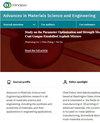Mechanical Behaviour of Glass Fibre-Reinforced Polymer/Polyvinyl Chloride Foam Cored Sandwich Structures
4区 材料科学
Q2 Engineering
引用次数: 0
Abstract
This study focuses on the fabrication and analysis of the mechanical behaviour of unidirectional (UD) glass fibre-reinforced polymer (GFRP) facesheet and polyvinyl chloride (PVC) foam core sandwich structures fabricated by a vacuum-assisted resin infusion method (VARIM). These sandwich structures are commonly used in marine and wind turbine blade applications. To date, relatively little knowledge about the functional behaviour of UD GFRP compared to composites reinforced with bidirectional mats is available for day-to-day applications. The effects of the facesheet orientation, facesheet thickness, and core thickness on the mechanical behaviour of the specimens were examined. The UD fibres were oriented in cross-ply (0/90), angle-ply (+45/−45), and quasi-isotropic orientations. Various mechanical properties such as tensile, flexural, flatwise compression, and edgewise compression tests were examined. Characterization of the tensile properties of the facesheet showed that the cross-ply orientation had a higher strength than the angle-ply and quasi-isotropic orientations. The flexural load-carrying capacity of the cross-ply facesheet orientation was superior to the other orientations. The increase in the core thickness changed the flexural failure mode from face yield and core shear to core indentation. Flatwise compression (FWC) was tested to determine the core characteristics of the sandwich structure, and the peak loads of 4.90, 1.81, and 3.90 kN were obtained for 10-, 15-, and 20 mm core thicknesses, respectively. Edgewise compression (EWC) exhibited stable end crushing for thinner facesheet, whereas thicker facesheet showed core crushing and buckling. When the facesheet thickness was increased from 1.5 mm to 3 mm in the EWC, the buckling load increase ranged from 2.53% to 44.83% for core thicknesses 10-, 15-, and 20 mm, respectively.玻璃纤维增强聚合物/聚氯乙烯泡沫芯夹层结构的力学行为
本研究的重点是通过真空辅助树脂灌注法(VARIM)制造单向(UD)玻璃纤维增强聚合物(GFRP)面板和聚氯乙烯(PVC)泡沫芯材夹层结构,并分析其机械性能。这些夹层结构通常用于船舶和风力涡轮机叶片。迄今为止,与使用双向毡增强的复合材料相比,人们对 UD GFRP 在日常应用中的功能特性了解相对较少。我们研究了面片取向、面片厚度和芯材厚度对试样机械性能的影响。UD 纤维的取向有交叉层(0/90)、角层(+45/-45)和准各向同性取向。对拉伸、弯曲、平面压缩和边缘压缩试验等各种机械性能进行了检验。面片的拉伸特性表明,交叉层取向的强度高于角层取向和准各向同性取向。交叉层方向面板的抗弯承载能力优于其他方向。芯材厚度的增加改变了弯曲破坏模式,从面层屈服和芯材剪切变为芯材压痕。平向压缩(FWC)测试确定了夹层结构的芯材特性,芯材厚度为 10 毫米、15 毫米和 20 毫米时的峰值载荷分别为 4.90 千牛、1.81 千牛和 3.90 千牛。较薄面板的边缘压缩(EWC)表现出稳定的端部挤压,而较厚面板则表现出夹芯挤压和屈曲。在 EWC 中,当面板厚度从 1.5 毫米增加到 3 毫米时,芯材厚度为 10 毫米、15 毫米和 20 毫米时,屈曲载荷分别增加了 2.53% 到 44.83%。
本文章由计算机程序翻译,如有差异,请以英文原文为准。
求助全文
约1分钟内获得全文
求助全文
来源期刊

Advances in Materials Science and Engineering
Materials Science-General Materials Science
CiteScore
3.30
自引率
0.00%
发文量
0
审稿时长
4-8 weeks
期刊介绍:
Advances in Materials Science and Engineering is a broad scope journal that publishes articles in all areas of materials science and engineering including, but not limited to:
-Chemistry and fundamental properties of matter
-Material synthesis, fabrication, manufacture, and processing
-Magnetic, electrical, thermal, and optical properties of materials
-Strength, durability, and mechanical behaviour of materials
-Consideration of materials in structural design, modelling, and engineering
-Green and renewable materials, and consideration of materials’ life cycles
-Materials in specialist applications (such as medicine, energy, aerospace, and nanotechnology)
 求助内容:
求助内容: 应助结果提醒方式:
应助结果提醒方式:


